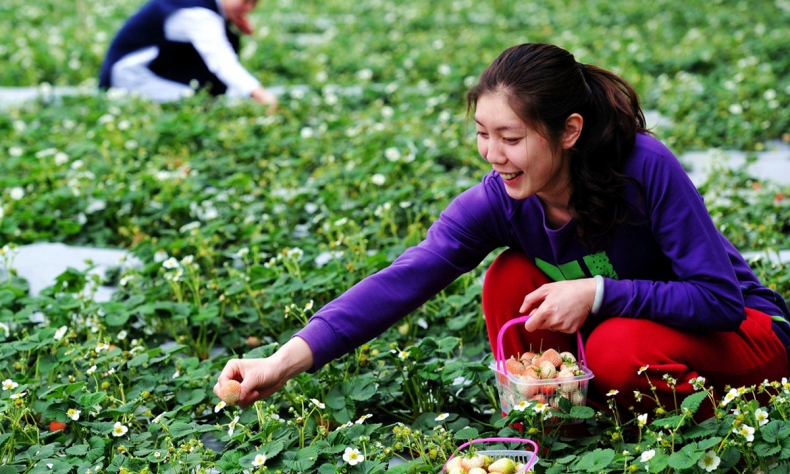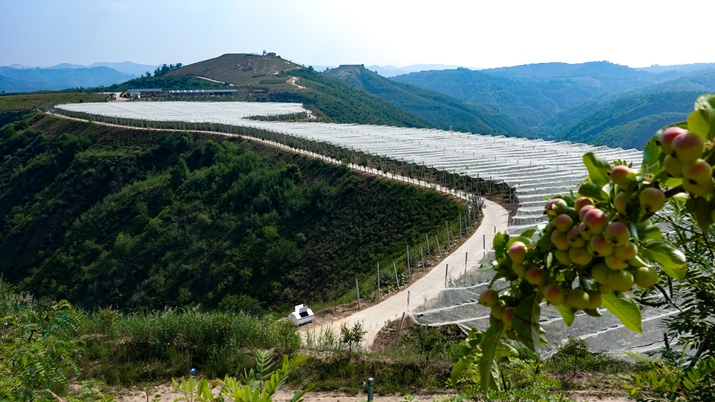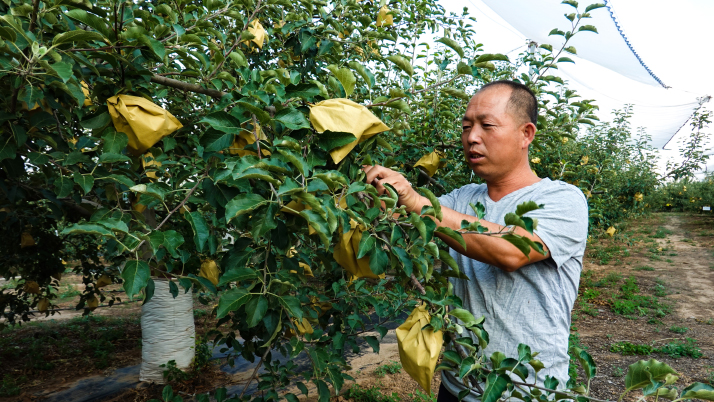
A Dual-Track Approach
A combination of modern agriculture and tourism creates wonders in disadvantaged areas
One day in 1969, a 15-year-old middle school student waved goodbye to his family in Beijing and headed for a desolate county in the northwest. In the late 1960s and 1970s, large numbers of educated urban youths were sent to the countryside to work and the teen was one of many. His name is Xi Jinping.
It was not a pleasant journey. It took Xi and the other young students a whole day on the train from Beijing to Tongchuan, a city in Shaanxi Province. After spending a night there, they hopped onto trucks for a bumpy journey for two more days. Xi and his friends had been asked to go to a remote village, Liangjiahe. They had to walk the last few miles to the village as the mountain tracks were too narrow for vehicles.

“Trucks ran round and round on the bumpy mountain roads… Every time I saw the bleak Loess Plateau, I thought we were about to arrive. But I would find more bleak places waiting ahead. I felt like the driver was taking us to the end of the world,” recalled Dai Ming, who was on the same truck with Xi.Dai’s memory of that journey has been recorded in Xi Jinping’s Seven Years as an Educated Youth, a compilation of interviews later conducted about the time Xi, today President of China, lived in Liangjiahe.
Life in the village was harsh. The students lived with scarce food and intense agricultural labor. Xi said in an interview in 2004 that they didn’t get to eat meat for months.
The bigger city that the village was part of faced the same harsh conditions. Yan’an was a city of barren lands, frequent droughts and floods, with an underdeveloped economy.
Fast forward to 50 years since Xi’s trip to Liangjiahe. Today, it takes only a couple of hours to go to Shaanxi’s Yanchuan County from Beijing by plane. The narrow mountain tracks have given way to broad asphalted roads where vehicles whizz past. The arid environment has improved with the once yellow and bald plateau covered by greenery.People’s living standards have also improved. In May, Yanchuan and Yichuan, the last two counties in Yan’an that were still below the poverty line, shook off their penury. According to the provincial poverty alleviation office, only 1.06 percent of the population in Yanchuan and 0.58 percent in Yichuan are still impoverished.
How did this social and economic revolution happen in this historical revolutionary base? Developing modern agriculture and tourism is part of the answer, Yan Jianhua, an official of the Poverty Alleviation Bureau of Yan’an, told Beijing Review.

Growing Money on Trees
“Every one of nine apples produced and sold in China comes from Yan’an,” Yan said proudly. Apple orchards have become a money spinner for many local farmers, like 61-year-old Zhang Zhiming.
The Zhangs became impoverished due to severe illnesses in the family. A plot of land was their only source of income but the traditional crops they planted couldn’t produce a sufficient income. Then nine years ago, Zhang began to plant apple trees. For seven long years, the time it took for the trees to bear fruit, he had to wait. The patience was rewarded last year when the trees began bearing fruit.
He sold the apples to a company that is buying apples from poor households to help them market their products and earned almost 70,000 yuan ($10,146). That was the year the delighted Zhang family said goodbye to poverty.
“Compared with growing corn, the traditional crop, apples are far more lucrative,” Yan said. Apples grown on one mu of land can yield 7,000 yuan ($1,014), while corn grown on the same plot will fetch no more than 600 yuan ($87). Mu is a traditional Chinese land area measurement, equaling 667 square meters.
Yan’an apples are famous for their high quality, thanks to the high altitude, abundant sunlight, large day and night temperature difference, and the dry weather. Encouraged by the local government, more and more households started to plant apple trees. By 2018, Yan’an had 230,000 hectares of apple orchards producing 3 million tons of the fruit.
“Our next step is to add value to the apple industry through post-processing, including sorting, packing, storing and marketing,” Yan said.
In Yichuan, the apples are grown on the mountains as the fruit likes sunshine. In the valley, farmers have switched to modern greenhouse agriculture supported by the local government.
Wangwan, a village in Yichuan with 110 households, was an impoverished village with over 40 percent living in poverty. Most of them were corn planters or worked as migrant laborers in cities.
Song Shuangping worked as a truck driver, while his wife planted corn in their plot of land. Then Song had a road accident and the medical expenses brought the family near bankruptcy.
To help such struggling families, the local government put money together with an investing company to build greenhouses in the village and brought agricultural technicians from Yan’an to train farmers to use the greenhouses. Every poverty-stricken family can use three or four greenhouses for free.
The farmers plant watermelons, strawberries, cherry tomatoes and seasonal vegetables.
“I started to plant seasonal fruits and vegetables in the greenhouses three years ago. Each greenhouse can make over 10,000 yuan ($1,449) a year,” Song told Beijing Review.
The village is only a 20-minute drive from the county seat and Wanqin, the company that invested in the greenhouses, now plans to develop the village into a scenic spot for tourists. They can enjoy picking seasonal fruit as well as fishing and marveling at the sea of peony flowers.

Tapping Tourism Potential
Other counties are also developing their tourism potential. Xiaocheng, a village in Yanchuan, though remote and mountainous, lies in a spectacular scenic area, the Qiankun Bay, developed in 2015 after the county government decided to make tourism a key development strategy.
In the past, due to the inaccessibility of the area, many people had never ventured out. Growing dates was the main form of livelihood supplemented by working as migrant labor.
But today the bay area has become a comprehensive tourism spot, offering boating on the Yellow River, grass skiing and local cuisine.
The farmers are changing tack. Hao Shibin, a 50-year-old villager, sells food to tourists at the scenic spot. He has also opened a barbecue restaurant, shaking off poverty.
“I started my small food business in 2009. But I began to make real money in 2015 after the scenic spot opened and tourists swarmed in,” Hao said. “During the peak of the tourist season, I can make 4,000 yuan ($579) a day.”
He has hired two people in his restaurant and in his way contributed to poverty alleviation.
The ripple effects of tourism can be seen in the dozens of households running a variety of tourism-related businesses such as providing transportation, selling fresh fruits and vegetables to restaurants, and running souvenir shops.
In the coming years, Yan’an will give priority to sustainable rural development to prevent farmers from falling back into poverty, Yan said. Government subsidies for poor households offered during the poverty alleviation campaign may be canceled, but the government will continue to improve the social safety net and public services, he added.
 Facebook
Facebook
 Twitter
Twitter
 Linkedin
Linkedin
 Google +
Google +










